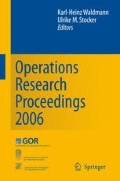Abstract
A common issue for firms is how to allocate capital resources to various investment alternatives. An extensive literature in finance has examined various aspects of capital budgeting, including capital constraints, the determination of discount rates, and alternative approaches to estimating cash flows and handling risk, such as real options techniques. In terms of organizational structure, a central feature of the capital budgeting process in large firms is that relevant information about the profitability of potential investment projects resides with one or several managers. It is generally accepted that preferences of these managers may not coincide with those of the firm’s owners (the principal). Consequences of asymmetric information include strategic reporting by better-informed managers (for example, “sandbagging” or “creative optimism”) and a need to measure performance ex post. Surveys consistently find that internal rate of return (IRR) criteria remain prevalent in capital budgeting decisions. Furthermore the use of artificially high hurdle rates suggests widespread capital rationing [15, 20].
Access this chapter
Tax calculation will be finalised at checkout
Purchases are for personal use only
Preview
Unable to display preview. Download preview PDF.
References
Antle, R. and Eppen, G. D. 1985, Capital rationing and organizational slack in capital budgeting, Management Science 31(2), 163–174.
Baldenius, T. 2003, Delegated investment decisions and private benefits of control, Accounting Review 78(4), 909–930.
Baldenius, T., Dutta, S. and Reichelstein, S. 2006, Cost allocation for capital budgeting decisions. Working paper.
Bareket, M. and Mohnen, A. 2006, Performance measurement for investment decisions under capital constraints. Forthcoming in Review of Accounting Studies.
Christensen, P. O., Feltham, G. A. and Wu, M. G. H. 2002, “Cost of capital” in residual income for performance evaluation, Accounting Review 77(1), 1–23.
Dutta, S. and Reichelstein, S. 2002, Controlling investment decisions: Depreciation-and capital charges, Review of Accounting Studies 7(2–3), 253–281.
Dutta, S. and Reichelstein, S. 2005, Stock price, earnings, and book value in managerial performance measures, The Accounting Review 80(4), 1069–1100.
Friedl, G. 2005, Incentive properties of residual income when there is an option to wait, Schmalenbach Business Review 57, 3–21.
Green, J. and Laffont, J.-J. 1979, Incentives in Public Decision-Making, North-Holland, Amsterdam.
Harris, M., Kriebel, C. H. and Raviv, A. 1982, Asymmetric information, incentives and intrafirm resource allocation, Management Science 28(6), 604–620.
Hodak, M. 1997, The end of cost allocations as we know them, Journal of Applied Corporate Finance 10(3), 117–124.
Lambert, R. A. 2001, Contract theory and accounting, Journal of Accounting and Economics 32, 3–87.
Pfeiffer, T. and Schneider, G. 2006, Residual income-based compensation plans for controlling investment decisions under sequential private information. Working paper.
Plambeck, E. L. and Taylor, T. A. 2005, Sell the plant? the impact of contract manufacturing on innovation, capacity, and profitability, Management Science 51, 133–150.
Poterba, J. M. and Summers, L. H. 1995, A CEO survey of U.S. companies’ time horizons and hurdle rates, Sloan Management Review 37(1), 43–53.
Reichelstein, S. 1997, Investment decisions and managerial performance evaluation, Review of Accounting Studies 2, 157–180.
Rogerson, W. P. 1997, Intertemporal cost allocation and managerial investment incentives: A theory explaining the use of economic value added as a performance measure, Journal of Political Economy 105(4), 770–795.
Rogerson, W. P. 2006, Intertemporal cost allocation and investment decisions. Working paper.
Stein, J. C. (1997) Internal capital markets and the competition for corporate resources, Journal of Finance 52(1), 111–33.
Taggart, R. A. 1987, Allocating capital among a firm’s divisions: Hurdle rates versus budgets, Journal of Financial Research 10(3).
Young, S. D. and O’Byrne, S. F. 2001, EVA and Value-Based Management: A Practical Guide, McGraw-Hill, New York, NY.
Author information
Authors and Affiliations
Editor information
Editors and Affiliations
Rights and permissions
Copyright information
© 2007 Springer-Verlag Berlin Heidelberg
About this paper
Cite this paper
Gow, I., Reichelstein, S. (2007). Capital Budgeting: The Role of Cost Allocations. In: Waldmann, KH., Stocker, U.M. (eds) Operations Research Proceedings 2006. Operations Research Proceedings, vol 2006. Springer, Berlin, Heidelberg. https://doi.org/10.1007/978-3-540-69995-8_19
Download citation
DOI: https://doi.org/10.1007/978-3-540-69995-8_19
Publisher Name: Springer, Berlin, Heidelberg
Print ISBN: 978-3-540-69994-1
Online ISBN: 978-3-540-69995-8
eBook Packages: Business and EconomicsBusiness and Management (R0)

